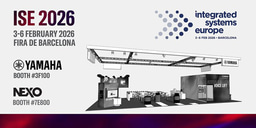IPMX: the new wings beneath HDBaseT

Room for growth
Despite widespread deployment, HDBaseT has always shown some weaknesses that competing – frequently AVoIP – technologies exploited. Such as a range limit (typically 100m) imposed by a run of CATx cable, and its inability to traverse an active IT network. Together these often meant that HDBaseT ‘islands’ developed – rooms and areas that could not easily ‘talk to each other’.
(Some AVoIP technologies propose ingesting HDBaseT but then converting the signals to something which they can handle, say HDMI, and transferring that to the other location. The receiving site then either becomes an HDMI native room or needs a pile of HDMI to HDBaseT adapters – typically third party - not from the same stable as the AVoIP encoder.)
The advent of IPMX has changed that. An IPMX network can now act as a conduit for HDBaseT - to the extent that what is extracted from the network at the receiving end is still HDBaseT.
IPMX – the game changer
IPMX has changed the offer that AV integrators can make to their clients. Now the integrator can offer ‘just the missing part’ of an AVoIP solution – without asking the client to ‘rip and replace’ perfectly viable endpoints. (HDBaseT equipped projectors for example are rarely low cost items – no-one wants to ‘retire’ them too soon – this new offer is very well received by the end-user).
Matrox Video, in the shape of its ConvertIP product, is the first to use IPMX to map HDBaseT to the network, from where it can be transported anywhere on the LAN. And because IPMX is a multicast environment, HDBaseT has also become a ‘one-to-many’ technology – using the network as a huge Distribution Amplifier!
The idea of taking the signal out in another format – as suggested by other AVoIP approaches remains – but as an option rather than a requirement. Additionally the ability to ingest from a source in one format – say SDI - and output as HDBaseT is possible. A mixed environment is also enabled without converting at baseband. It becomes clear how the Matrox ConvertIP gets its name!
A closing thought or two
Whilst many associate, quite reasonably, ‘uncompressed’ video with high-end tv studios, this is a very timely reminder that HDBaseT - a technology firmly rooted in AV not broadcast – is an uncompressed approach when you delve inside it. And IPMX can support that quality too – as well as offering a variety of 'visually lossless' approaches to the existing endpoints. It does this by giving the user choice about which network bandwidth (eg 1Gbps, 10Gbps, 25Gbps) to adopt – rather than forcing their hand.
Those premises where HDBaseT is installed now have a new route to deploying AVoIP that does not involve scrapping their existing equipment. Significantly, it widens the HDBaseT scope from room-level to site-level thinking.
Recommended Content
2026 Preview – What Our Experts Anticipate This Year






Please sign in or register for FREE
If you are a registered user on AVIXA Xchange, please sign in